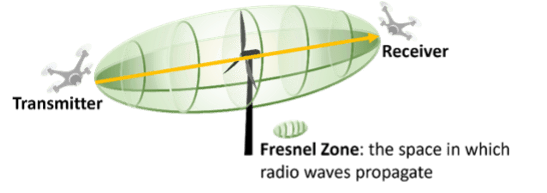
Researchers from Japan have developed a methodology for using two drones to inspect wind turbines without shutdown: significantly impacting the cost of maintenance. Read on to learn how it works.
Continue reading below, or listen:
Japan’s NTT has been a leader in telecommunications since 1952. DRONELIFE is honored to present this article by one of NTT’s distinguished research teams, led by Senior Research Engineer Tatsuya Nakatani. DRONELIFE neither accepts nor makes payment for guest posts.

Senior Research Engineer – Tatsuya Nakatani
Engineer -Takamasa Yoshida
Research Engineer – Fumiaki Nagase, Ph.D
Executive Research Engineer – Takeshi Onizawa, Ph.D
How Drones Are Making Wind Turbines Even More Sustainable
by Tatsuya Nakatani, NTT Senior Research Engineer
The past decade, according to the Columbia Climate School, the use of drones in applied research skyrocketed as the technology size and prices decreased while the capabilities of cameras, sensors and battery power increased. That is true across fields—health, ecologically, environmentally and more.
Today, researchers are even applying drones to optimize the production of alternative energy in the hardest-to-reach places: offshore wind turbines.
Energy produced by wind is vital to the global adoption of renewable energy sources; however, the costs of operations and maintenance remain an obstacle, especially for offshore wind turbines. A 2022 report from the International Energy Agency found that wind electricity generation increased at a record level of 273 TWh (17 percent) in 2021—55 percent higher growth than achieved in 2020 and, “the highest among all renewable power energies.” Yet, this report states that “the operation and maintenance cost is very high for wind turbines, accounting for almost 30% of the total wind turbine cost, which is one of the major factors hindering market growth.” The two largest cost drivers for wind turbine operational expenditures are the distance from the project to the maintenance facilities and the meteorological climate at the project site, according to the National Renewable Energy Laboratory.
Researchers with NTT recently unveiled a solution. By using two drones, researchers developed a system by which the wind turbines may be monitored for performance and damage without having to first turn the turbines off, greatly limiting the energy production that is typically lost during inspection downtime.
How, exactly, does the technology work? The Fresnel Zone
NTT’s researchers conducted the world’s first successful experiment by which two drones were used to simulate weak radio transmitters and receivers—one drone acting as a transmitter, the other the receiver. The researchers conducted an outdoor experiment to send and receive weak radio signals in the sky, successfully demonstrating transmission and reception at an altitude of 30 meters.
The results depended on the creation of a Fresnel Zone, which can be defined as, “the subsurface area which reflects energy that arrives at the earth’s surface within a time delay equal to half the dominant period.” In layman’s terms, a Fresnel Zone is what enables radio waves to propagate within a given space.
By creating a Fresnel Zone around an operating wind turbine, the weak radio signals can be both transmitted and received (Fig. 1).

Fig. 1: Creation of a Fresnel Zone Around an Operational Wind Turbine Using Two Drones
Then, by comparing data collected via weak radio transmission and reception on a windmill model with rotating blades, researchers confirmed variations in reception levels when performing the test on damaged versus undamaged blades.
So, what must be done before these scientific results can be implemented in real wind farms? As noted above, researchers achieved a successful weak radio signal transmission at a height of 30 meters; however, wind turbines are typically around 80 meters tall in the U.S. Before this technology can be deployed, researchers must be able to create a Fresnel Zone at higher altitudes. The work to do so is already underway, with NTT researchers planning to successfully demonstrate the technology at 80 meters in the next three years.
Plus, the benefits of drone-based monitoring are not limited to wind turbines. For example, NTT Communications and NTT DOCOMO launched a blade-free, blimp-type drone equipped with a high-resolution video camera that captures high-quality video and full-color LED lights that glow in radiant colors to maximize problem solving and data entry. Through its blade-free design, this drone can aid in facility inspections, infrastructure inspections, agricultural monitoring (such as detecting weeds and analyzing field conditions) and even disaster response.
Drone technology provides an extremely adaptable, resilient foundation upon which additional technologies can be added to diversify functionality. Its supplementation of research across scientific fields is having a significant impact on the world today, with the great potential of making an even bigger impact in the near future.
Read more:
- Inspecting Wind Turbines Without Stopping Them: Japanese Company Demos Drone Technology
- Drones for Wind Turbine Inspection: ONYX Insight and Nearthlab Partner on Predictive Maintenance

NTT Senior Research Engineer, Tatsuya Nakatani led the research into the Fresnel Zone method of drone inspection for wind turbines.

Miriam McNabb is the Editor-in-Chief of DRONELIFE and CEO of JobForDrones, a professional drone services marketplace, and a fascinated observer of the emerging drone industry and the regulatory environment for drones. Miriam has penned over 3,000 articles focused on the commercial drone space and is an international speaker and recognized figure in the industry. Miriam has a degree from the University of Chicago and over 20 years of experience in high tech sales and marketing for new technologies.
For drone industry consulting or writing, Email Miriam.
TWITTER:@spaldingbarker
Subscribe to DroneLife here.







[…] Miriam McNabb is the Editor-in-Chief of DRONELIFE and CEO of JobForDrones, a professional drone services marketplace, and a fascinated observer of the emerging drone industry and the regulatory environment for drones. Miriam has penned over 3,000 articles focused on the commercial drone space and is an international speaker and recognized figure in the industry. Miriam has a degree from the University of Chicago and over 20 years of experience in high tech sales and marketing for new technologies.For drone industry consulting or writing, Email Miriam. […]